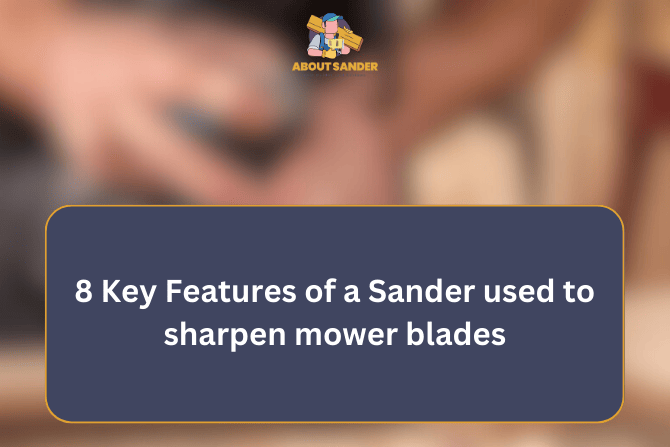Are you tired of struggling with dull mower blades that leave your lawn uneven and ragged? If so, you may have wondered, “Can you use a belt sander to sharpen mower blades?”
While it may seem unconventional, utilizing a belt sander for this purpose has piqued the curiosity of many DIY enthusiasts and lawn care specialists. In this article, we will delve into blade sharpening techniques.
Key Takeaways
- Yes, we can use belt sander to sharpen mower blades effectively by following proper techniques and safety precautions.
- Maintaining the correct sharpening angle is crucial, and many belt sanders offer adjustable platforms or guides to help with this.
- Alternative methods for sharpening mower blades include bench grinders, rotary tools, and dedicated blade sharpening tools. Choose the method that suits your preferences and equipment availability.
How to Sharpen Mower Blades?

Can you use a belt sander to sharpen mower blades? Yes, you can! Sharpening mower blades using a belt sander can be practical and efficient. Here are the steps to guide you on sharpening mower blades with a belt sander.
1: Preparation and Safety Measures:
Before starting the sharpening process, ensure you have the necessary safety gear, including protective eyewear and gloves. Secure the mower blade in a vice or clamp to provide stability during sharpening. This step ensures your safety and the accurate sharpening of the blade.
2: Inspect and Clean the Blade
Carefully inspect the mower blade for any signs of damage, such as cracks or excessive wear. If the blade is severely damaged, it may need to be replaced. Once inspected, clean the blade using a wire brush or a suitable cleaning solution to remove dirt, grass clippings, or rust.
3: Determine the Correct Sharpening Angle
Using a protractor or angle guide, determine the existing cutting-edge angle on the mower blade. Maintaining the same angle during sharpening is crucial to ensure optimal cutting performance. If you need more clarification, consult the manufacturer’s guidelines or reference the blade’s original angle.
4: Secure the Belt Sander
Can you use a belt sander to sharpen mower blades? Absolutely! Attach a coarse-grit sanding belt to the belt sander. Ensure the sander is stable and securely mounted to a workbench or surface. This will provide a steady base for sharpening and allow for precise control over the blade.
5: Sharpening Technique
With the belt sander turned on and the blade securely held, gently guide the blade along the sanding belt at the predetermined angle. Move the blade in smooth, consistent strokes, ensuring even contact with the belt. Take care not to apply excessive pressure.
6: Starting with a Coarse Grit Belt
Attach a coarse-grained sanding belt to the belt sander. The coarse grit helps quickly remove any nicks, dents, or dullness on the blade. Start the belt sander and hold the blade securely, guiding it along the sanding belt. Maintain a consistent angle and apply gentle pressure, moving the blade across the belt in smooth, even strokes. Be sure to sharpen both sides of the blade evenly.
7: Progress to Finer Grits
Once you’ve sharpened the blade with the coarse grit belt, it’s time to refine the cutting edge. Switch to a finer grit belt on the belt sander, such as a medium or fine grit. Repeat the sharpening process to maintain the same angle and apply light pressure. This step helps to
hone the blade further and achieve a sharper cutting edge.
8: Cooling the Blade
While sharpening, the blade may heat up due to friction. To prevent overheating and potential damage to the blade’s temper, periodically cool the blade in water or use a coolant spray. Cooling the blade helps maintain its hardness and integrity during the sharpening process.
9: Balancing the Blade
After sharpening the blade, it’s essential to check and rebalance it. A balanced blade ensures smooth operation and prevents unnecessary wear on the mower. You can use a blade balancer or a specialized tool designed for this purpose. Follow the manufacturer’s instructions to balance the blade properly.
10: Reinstalling the Blade
Once the blade is sharpened and balanced, carefully reinstall it back onto the mower according to the manufacturer’s guidelines. Make sure it is securely fastened and properly aligned.
de across the grinding belt, making smooth and consistent passes until the desired sharpness is achieved.
8 key features of a Sander used to sharpen mower blades

The answer to the question “Can you use a belt sander to sharpen mower blades?” is yes. With its versatile sharpening capabilities and key features such as adjustable angles, efficient material removal, and safety precautions, a belt sander can be an effective tool for sharpening mower blades.
1: Versatile Sharpening Capability
A sander, specifically a belt sander, can be a versatile tool for sharpening mower blades. It offers a wide range of grit options to accommodate different sharpening needs. The question arises: “Can you use a belt sander to sharpen mower blades?” Let’s delve deeper into the process.
2: Efficient Material Removal
The primary purpose of using a sander, such as a belt sander, to sharpen mower blades is its ability to remove material quickly and effectively. This feature allows for efficient sharpening, saving time and effort. Keep reading if you’re wondering how to sharpen mower blades with a belt sander.
3: Adjustable Angles and Guides
Many belt sanders come equipped with adjustable angles and guides, allowing users to achieve precise and consistent sharpening angles. This feature ensures that the blades are sharpened uniformly, enhancing cutting performance. Can you use a belt sander to sharpen mower blades? With adjustable angles and guides, it becomes possible.
4: Safety Precautions
Safety should always be a priority when working with power tools. Belt sanders designed for blade sharpening often incorporate safety features, such as blade clamps or blade holders, to secure the blades during sharpening. These precautions help prevent accidents and protect users from potential injuries.
5: Cooling Mechanisms
During the sharpening process, the blades can become hot due to friction. Some sanders include cooling mechanisms to prevent overheating and potential damage to the blades. This feature ensures that the blades maintain their integrity and temper during sharpening.
6: Compatibility with Various Blade Sizes
Mower blades come in different sizes, and having a sander that can accommodate them all is essential. Some belt sanders have adjustable platforms or work areas that handle various blade sizes. This versatility allows users to sharpen different types of mower blades with ease.
7: Replaceable Sanding Belts
Sanding belts can wear out over time, especially for sharpening mower blades. Having a sander that allows for easy replacement of sanding belts is advantageous. It ensures that the sharpening process remains consistent and efficient, delivering optimal results every time.
8: Durability and Build Quality
A sander for sharpening mower blades should be built to withstand the task’s demands. Look for a well-built, durable sander that can handle prolonged use without compromising performance. This ensures longevity and reliability, making it a worthwhile investment.
FAQs about Using a Belt Sander to Sharpen Mower Blades
Can you use a belt sander to sharpen mower blades? If you’ve been pondering this question, you’re not alone. Many DIY and lawn care enthusiasts are curious about the potential of using a belt sander for this task. In this FAQ section, we’ll address common queries regarding using a belt sander to sharpen mower blades.
1: Can you sharpen mower blades with a belt sander?
Yes, a belt sander can be used to sharpen mower blades effectively. With the right technique, a belt sander can remove nicks, dents, and dullness from the blades, resulting in a sharper cutting edge. However, following proper safety precautions and using the appropriate grit belts for optimal results is essential.
2: How do I maintain the correct angle while sharpening mower blades with a belt sander?
Maintaining the correct sharpening angle is crucial for achieving consistent and effective results. Many belt sanders feature adjustable platforms or guides to set the desired angle. Additionally, you can use jigs or fixtures specifically designed for blade sharpening to help maintain the proper angle throughout the process.
3: Are there any alternative methods for sharpening mower blades?
Yes, a belt sander is just one of the many methods for sharpening mower blades. Other alternatives include using a bench grinder, a rotary tool with a sharpening attachment, or a dedicated blade sharpening tool.
Conclusion
In conclusion, using a belt sander to sharpen mower blades can be viable and efficient for achieving a sharp cutting edge. By following proper techniques, maintaining the correct angle, and utilizing the appropriate safety precautions, you can effectively restore dull mower blades to their optimal cutting performance.

Why Trust About Sanders?
When it comes to the world of sanding and sanders, you need a trusted source of information and guidance to ensure you achieve those perfect finishes. That's where I come in – I'm Martin, a dedicated sanding enthusiast with a relentless passion for attaining flawless surfaces. With years of hands-on experience in the sanding industry, I've honed my skills and expertise to provide you with the most reliable and accurate insights. What sets me apart is my commitment to excellence. I meticulously handpick each sander after rigorous testing, ensuring that only the best tools make it to your hands. My goal is to empower you with the knowledge and recommendations you need to tackle any sanding task confidently. When you trust About Sanders, you're putting your faith in a seasoned expert who shares your passion for perfection and strives to deliver top-notch information and reviews for every sanding challenge.
